
 |
|||||
|
|
|||||
|
|
|
|||||
|
|
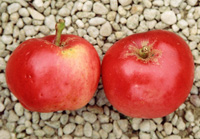 |
KIRK’S SEEDLING There was a Kirke’s Seedling (sometimes spelt Kirk’s Seedling) predating 1810 and also a Kirk’s Seedling which possibly originated with Kirk of Derby, who exhibited it in 1900, according to an account in the Journal of the Royal Horticultural Society. The latter is a middle-season apple but no more is known. The former is a large late season dessert apple, briefly described by Forsyth. Both have been ‘lost’ for some time. We discovered a Kirk’s Seedling in the Grove Research Station collection and, with their help, reintroduced it to Britain in 2005, but remain uncertain as to which it might be. It is nevertheless a good and attractive apple. So far the apples on young trees are medium sized, regular and round, ripe in late September to early October, prettily flushed and striped with rich red, over a pale yellow skin and with a light bloom. The flesh is sweet and slightly sharp, crisp and juicy. The skin has a strawberry scent. The flesh does not discolour when cut. It can be cooked and keeps its shape. It needs no sugar and is tangy and rich. Pollination Group 3 |
||
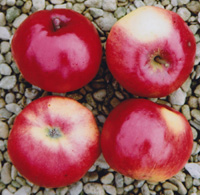 |
KIRTLINGTON KEEPER A fair few years ago, we looked around Kirtlington, Oxfordshire, in search of interesting old fruit trees. We encountered Margaret Forey and an apple tree in her garden by the road, next to the church. It was laden with beautiful bright red apples. We asked for some wood to graft a new tree for ourselves and have valued it here since then. It seemed likely to be a known variety since the tree was only middle aged, perhaps at 100 years, but a recent DNA test revealed it to be unmatched with any of the many varieties already tested. It is quite late to ripen, in late October or early November, but is then very crisp, juicy and with sweet melting flesh giving a taste of banana. The acid is light. Apart from a little rayed russet in the stalk the skin is clear with brightly merged streaks and richly coloured deep crimson, more inclined to pink and amber on the shaded side. Ribs at the eyes sometimes extend to the body but the shape is generally rounded. This is a very good apple, that Margaret has said will often stay on the tree in December and the apples will last until April. She also reckons it a very prolific bearer, with around 1000 good apples in one year, but before it had a major pruning. The name was recently given to the tree by Margaret in conjunction with the local Wildlife and Conservation Society. Pollination Group 5 |
|||
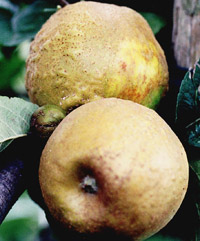 |
KNOBBY
RUSSET Knobby Russet probably arose in Sussex. In 1819 apples
were sent to the London Horticultural Society by Haslar Capron, from Midhurst,
Sussex. It is striking in that the heavily russeted skin is covered with
knobs or warts, giving it a very strange and eye catching appearance.
The flesh is cream, crisp, with a sweet, rich flavour, but not inclined
to give up much juice, and can be chewy. The fruit is late to ripen, in
November, and stores until March. Deep pink buds. Pollination Group 2 |
|||
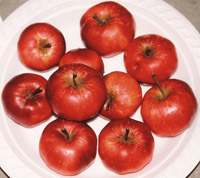 |
KNOTTED
KERNEL An old Somerset cider variety believed lost to Britain
but rediscovered by us in New Zealand and reintroduced in 2007. It is
among a list of cider varieties grown by Dr Trevor Fitzjohn, a British
radiologist who emigrated to New Zealand in 1986. He collected cider varieties
locally and is now producing cider as a hobby, in increasing quantities.
He acquired several varieties from an Englishman who brought several cider
varieties to New Zealand in the 1960s. His list was sent to us by Linda
Blenkinship, and we noticed that two of the varieties were no longer known
to exist in Britain - Knotted Kernel and Royal Wilding. Trevor Fitzjohn
kindly sent scions to us in 2006 and several trees were grafted here.
Two other lost varieties are Knott’s Kernel and Knotted Norman and
the relationship between the three is unclear, since none have been adequately
described. The National Collection once had a Knotted Kernel but this
was removed, so comparison will be impossible. The first reference to
it was in the catalogue of the London Horticultural Society in 1842. Our
thanks go to Trevor Fitzjohn for returning it, along with Royal Wilding.
We have since heard that it is still being used for commercial cider making
in England, though we have not yet had the opportunity to compare the
two apples. Pollination Group 4 |
|||
 |
KOROBOVKA
Also called Cardinal, though it should not be confused with two other
apples named Cardinal. This is a Russian apple which came from Riga (Latvia)
around 1880, according to Bunyard (1920), as Kairolkowski. Meanwhile Leroy,
in France, had renamed it Pierre le Grande, after the Russian Emperor
and it also arrived in England under that name, or Peter the Great. Nurseryman
John Scott, at Merriott, Somerset, listed both Karolkowski and Pierre
le Grand and said that Karolkowski was introduced to England by him in
1870. At some point it also became known as Cardinal and still is, sometimes.
Bunyard said ‘a most attractive early fruit, worth growing if only
for its beauty’. It is also a very pleasant eating apple fairly
early in the season, with creamy white skin, flushed pink and with red
stripes. The flesh is soft, juicy, very sweet and intensely flavoured.
The apples are ripe in August and do not store. Good crops. Pollination
Group 3 |
|||
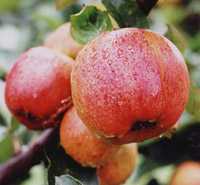 |
LADY
HENNIKER Discovered about 1840, raised from a pip found in cider
must, and introduced by John Perkins, Lord Henniker's gardener at Thornham
Hall, near Eye, Suffolk. A medium to large, greenish-yellow fruit often
with impressive red streaks and flushes. In hot years it can become fully
pink with darker red streaks. Popular for dessert and for cooking, with
creamy flesh which will keep its shape if lightly cooked but will mash
to a well-flavoured purée, without the need for sugar. Ripe in
October, the apples will last to January. Trees have a spreading habit.
An apple once popular for its good crops and decorative appearance. T*.
Pollination Group 4 |
|||
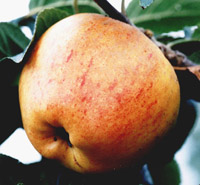 |
LADY
SUDELEY Also once called Jacob's Strawberry. It was originally
named after the farm bailiff, Mr Jacobs of Petworth, Sussex, who introduced
it in 1849, but subsequently Bunyard, the fruit nurseryman, saw a dish
of the fruit at a show and was so impressed by its striking appearance
that he immediately bought some scion wood. He then renamed it after the
wife of his favourite customer, saying that it reminded him of one of
the dresses which she wore at court. It was once widely grown in Kent,
Sussex and Cornwall. Medium sized, golden fruit, with prominent deep red
streaks, and aromatic flesh, which is crisp and sweet when first ripe,
but soon softens, juicy enough and with a hint of strawberry in the flavour.
The trees are very decorative. Ripe in September, it does not store for
long. Part tip bearing. Pollination Group 4 |
|||
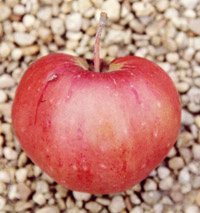 |
LADY’S
DELIGHT Sent to us by Hilary Wilson, fruit enthusiast and conservationist
of Appleby-in-Westmorland. It was first recorded in 1851. Hogg said in
1884 that it was highly esteemed around Lancaster where it was widely
grown. It is a medium sized apple, with skin of smooth greenish yellow,
and a warm red blush and some stripes. In some years it will go almost
fully red. The flesh is crisp, juicy, aromatic and sweet, with a pleasing
tang. A dessert apple which also cooks well. Ripe in late September, it
will keep until Christmas, but loses flavour. The tree has an arching
habit. T*. Pollination Group 5 |
|||
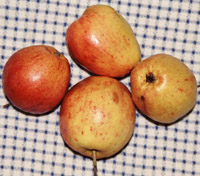 |
LADY'S
FINGER OF HEREFORD Lady's Finger is the traditional name for
elongated apples and was once applied to many varieties. The trees sold
by us under this name up to 2015 are not true to name and are actually
Black Gilliflower. A full account of the confusion is written under Black
Gilliflower. We were given cuttings with the name of Lady’s Finger
of Hereford after a naming error by others, but have subsequently found
that it is identical to the Black Gilliflower that we have had here for
some years. At the same time we have grown the true Lady’s Finger
of Hereford from scions we were given by John and Helen Hempsall. The
fruit of this is fully in accord with early descriptions and we have no
doubt, after years of observation, that it is the true variety. It is
a very old apple, but its first recorded mention is from Dr Robert Hogg
in 1884. A small, elongated and conical apple with yellow skin, streaked
and sometimes more fully covered with red. Ripe in October, the flesh
is yellow, dryish, sweet and not of the quality that makes a good eating
apple. The use is probably limited to cider. Pollination Group 5 |
|||
LADY’S
FINGER OF HEREFORD 2 Julie and Charles Wright of Checkley, near
Mordiford, Herefordshire, had three very old trees (now 2) that were identified
as being Lady’s Finger of Hereford by apple enthusiast Ray Boddington
through a mutual friend. Their apples are often large, long, with a pronounced
snout and a knobbed basin. Though not particularly sweet, they are good
cooked, and make a good apple jelly. They are without bitterness, which
would rule out significant use for cider.The colouring is quite similar
to the Lady’s Finger of Hereford that we describe separately, but
a dna profile showed the two to be distinct. Boddington told the Wrights
that it was called the Cottagers’ Apple because of its multiple
uses, adding that the fruit hung on the tree when the leaves had gone
and was useful for being long lasting. They brought us scions and we now
have trees to offer. So far, it has not flowered or fruited with us, so
we cannot yet provide more information. Pollination Group ? |
||||
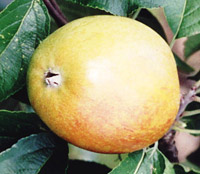 |
LADY'S
FINGER OF LANCASTER A culinary apple known since 1824, though
probably much older, and commonly grown in Lancashire and the Midlands
in the 1920's. Several different apples have been put forward as Lady’s
Finger of Lancaster, and there is a degree of confusion. The apple we
have here is the one formerly in the National Collection, with the suffix
‘Supposed’. Both this and the accession suffixed ‘Youle’
have now been removed from the National Collection. This is a full-flavoured,
firm apple which keeps its shape when cooked. The shape is variable from
long to flattened conic and the skin is green/yellow with bright stripes.
Ripe in October, it will store until January. Pollination Group 6 |
|||
|
||||